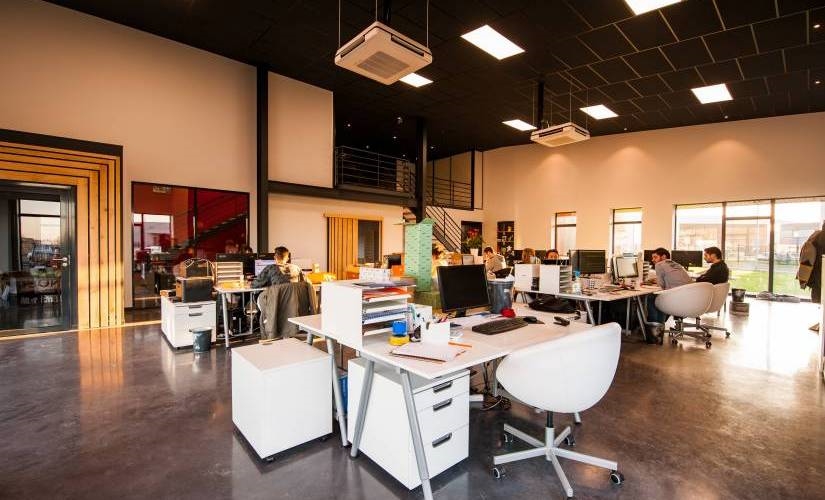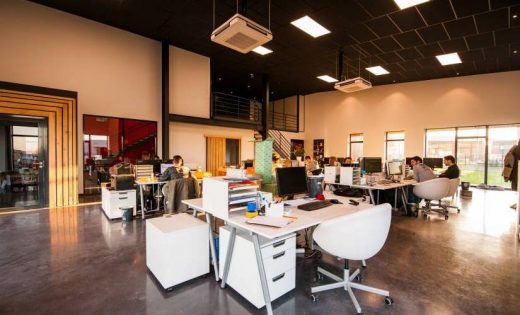7 Rules for Creating a Healthy Working Space in the Office
7 Rules for Creating a Healthy Working Space in the Office

We are currently going through some serious transformations in the current workflow. The format and speed of work are changing, and the office environment is changing as well. Customers are increasingly asking architects to create offices that are not just functional and with specific brand-specific aesthetics, but also include areas for recreation, communication, and sports. Such offices increase labor productivity and make it easier to come up and implement bold ideas faster.
To create a healthy “green” office space, it is necessary to push the boundaries of standard perception, for example: “every employee should have their own stationary workplace” or “it is most convenient to work while sitting.” Technical progress, ergonomics, and knowledge of the basics of a healthy lifestyle will help us with this task. In a healthy office, the working day turns into a healthy event. We have compiled seven rules for a healthy office interior.
7 Rules for a Healthy Office
1. Creating an acoustic comfort.
Not all office employees are satisfied with their open space workplace and believe that they could be much more productive in a quieter space. Many employees spend half their time in concentration — but the calm may not be solving their problems.
If we talk about simple building techniques: open ceilings, glass partitions, enclosing walls and windows, linoleum on the floor – all this together dampen up to 3% of the sound or reflects it (glass jar effect). The easiest ways to improve the situation are the use of carpets, suspended ceilings and separation screens of workstations above eye level, as well as phyto walls.
Often we have to resort to unique means, like closing glass, bare concrete, and other glossy surfaces, creating physical barriers to sound in the form of screens, soft and “green” phyto walls. Popular booths and mini-rooms for noisy telephone conversations. Decorative elements made of felt and other sound-absorbing materials help reduce decibels inside the room which helps employees not be distracted by annoying noises.
2. Use every square foot as a benefit for the body.
If you are lucky enough to have a courtyard, you can hold meetings there in good weather, put outdoor furniture so that employees can dine in the fresh air, you can even organize a small sports ground. Sports help to shift attention and get some rest in a short amount of time.
Air quality for both sports and work must be at the highest standard. To do this, the building itself should have high-quality ventilation and air-conditioning systems, “smart” humidity control systems. Some devices will help not only to control the smell but also to create pleasant fragrances.
Since all five human senses are involved in the perception of any space, to bring the interior concept to perfection, aroma designs are now gaining popularity. The fragrance allows you to create an atmosphere appropriate to the room.
The terrace is not a waste of working space, as was previously thought, but a bargain purchase. Here you can hold meetings, including with clients (fresh air removes barriers), celebrate collective holidays, and have a good rest for a few minutes.
3. Let there be light.
It is essential to plan and arrange the workplaces so that employees receive a lot of sunlight. You can use unique films to control the level of insolation. They will protect against ultraviolet radiation and allows the air inside the room to not heat up.
You should also pay attention to the lamps that will be used in the office. Incorrectly designed light not only hurts eyesight but also increases fatigue. The optimum light temperature and the shade of light, suitable for the office, will be selected by the lighting technicians, who, as a rule, are hired during the project development phase.
4. Oxygen cocktail.
Using plants is an inexpensive and effective way to reduce employee stress and improve the office environment. They are a powerful antioxidant, anti-stress and air purifier. They can fight with bronchitis and seasonal epidemics, pathogenic microbes, and fungi. They also release many useful substances into the surrounding space. Plants help increase the humidity of the air, fight dust, ionize the air, and fill the room with pleasant aromas.
5. Creating different scenarios for work.
The working space should be dynamic, that is, employees can work not only sitting, but also standing, sometimes even lying down. An inexpensive way to change the position of the body – several puffs, pillows or levels can be placed in a room or distributed throughout the office. Many furniture factories offer exciting solutions for work from different points of the office, for example, benches with built-in USB charging ports, or a place for exercise.
Some companies – especially those in the creative industry – take into account the fact that employees can get carried away with work so much that they forget about sleep. Therefore, the office can be equipped with special recreation areas where employees can nap.
6. Protecting the backs, arms, and brains.
It is necessary to approach the choice of furniture, especially the working chair, with special scrupulousness. A high-quality and thoughtful chair is the key to a healthy back.
A chair is a critical element when planning a workplace, be it at home or the office. The average consumer does not notice how they sit and on what. But at the end of the working day, the daytime vigor is replaced by back pains, fatigue, and impaired concentration. That’s why it’s so important to choose the right chair for the primary time of your work life.
During the working day, doctors recommend changing the sitting position to a standing one. Due to this, there is no stagnation of blood and lymph, and the brain cells are activated due to active oxygenation.
7. Good rest improves work efficiency.
The office should have space for recreation: game zones, coffee points, telephone booths for personal and work conversations. The game zone perfectly removes the accumulated stress. There can be various versions of games – table football, hockey, air hockey, table tennis, and darts. There can also be a place for board games.
Coffee points often become a place of spontaneous creative brain-storming, including interdisciplinary discussions with a high synergistic effect. Colleagues from different business divisions can meet over coffee — and talk here.
The post 7 Rules for Creating a Healthy Working Space in the Office appeared first on ReadWrite.
(21)


